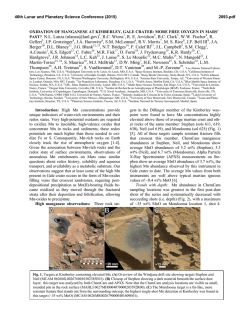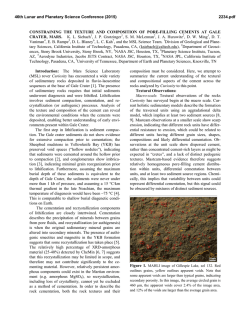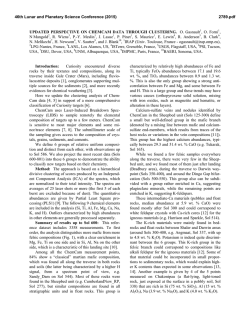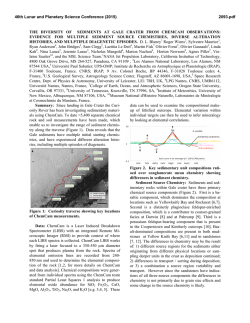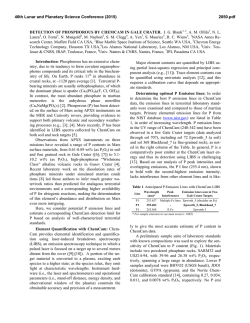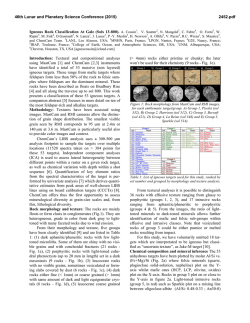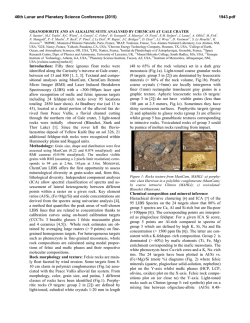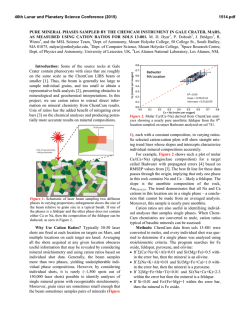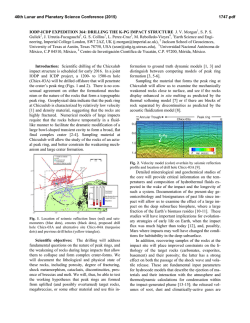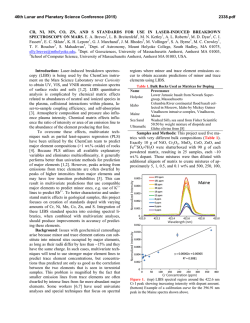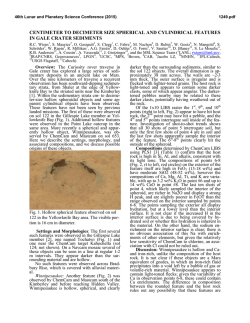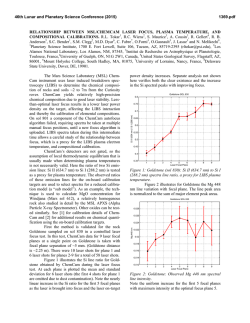
1438
46th Lunar and Planetary Science Conference (2015) 1438.pdf THE POTASSIC SEDIMENTARY ROCKS IN GALE CRATER, MARS AS SEEN BY CHEMCAM ONBOARD CURIOSITY. L. Le Deit1, N. Mangold1, O. Forni2, D. Blaney3, A. Cousin2, G. Dromart4, C. Fabre5, M. Fisk6, O. Gasnault2, N. Lanza7, J. Lasue2, S. Le Mouélic1, S. Maurice2, M. Nachon1, W. Rapin2, M. Rice8, V. Sautter9, S. Schröder2, D. Sumner10, R. C. Wiens7, 1LPG-Nantes, France ([email protected]), 2IRAP, Toulouse, France, 3JPL, Caltech, Pasadena, USA, 4LGTPE, ENS Lyon, France, 5G2R, Nancy, France, 6College of Earth, Ocean, and Atmospheric Sciences, Corvallis, USA, 7Los Alamos National Laboratory, USA, 8Western Washington University, Bellingham, USA, 9LMCM, MNHN, Paris, France, 10Earth and Planetary Sciences, University of California, Davis, USA. Introduction: The Mars Science Laboratory (MSL) rover Curiosity encountered potassic sedimentary rocks along its traverse to Mount Sharp. Those rocks are primarily located in two geological units: a light-toned topographically variable, or “Rugged unit”; and overlying light-toned striated rocks forming a “Striated unit” [1]. They have been primarily analyzed by the ChemCam instrument that combines a LaserInduced Breakdown Spectroscopy (LIBS) instrument [2, 3] and a Remote Micro-Imager (RMI) [4] at two waypoints informally named Cooperstown (sols 438 to 453) and Kimberley (sols 576 to 632). The acquisition of more than 50 ChemCam rocky targets at those two locations provides a good sampling for analyzing the spatial and stratigraphic compositional variability within the Rugged and the Striated units. Here, we report a synthesis of the chemical composition of the potassic rocks as seen by ChemCam according to their stratigraphic unit and facies at Cooperstown and Kimberley. Stratigraphy and rock facies: Cooperstown (4.62°N, 137.42°E) is a topographic depression located between -4495 m and -4493 m in elevation. It is associated with the Rugged unit, which is topographically above the Yellowknife Bay Formation (YKB) investigated during the first phase of the mission [1]. The Cooperstown formation can be subdivided into two members: a nearly flat-laying “Pine_Plains member” corresponding to fine-grained sandstones; and an overlying “Rensselaer member” characterized by a ledge of well-cemented pebbly sandstones containing float clasts. Kimberley (-4.64°N, 137.4°E) is an area between 4484 m and -4479 m in elevation marked by the presence of three mounds (Fig. 1A). The Kimberley formation includes seven members, which are in stratigraphic order: the basal Point_Coulomb member constituted of breccio-conglomerates analyzed by ChemCam on sol 550 in the Violet Valley; the Liga member made up of planar-bedded very coarse sandstones containing granules; the Square_Top member corresponding to south-dipping faintly-laminated sandstones; the Dillinger member containing cross-stratified sandstones in which Curiosity drilled; the butte-forming massive sandstones of the Mt. Remarkable member; and fine-grained resistant boulders possibly related to the Hummocky Plains unit, or “Beagle member” (Fig. 1B) [5, 6]. The Dillinger and Mt. Remarkable members are associated with the Rugged unit and are located stratigraphically between the Hummocky Plains unit and the Striated unit. The Square_Top and Liga members are associated with the Striated unit (Fig. 1B). Chemical composition: The sedimentary rocks of the Cooperstown and Kimberley formations have a basaltic-like composition according to Partial Least Squares (PLS), a multivariate regression method [7] (Fig. 2A). Those sedimentary rocks primarily differ in composition from the previously encountered Fig. 1: Overview of the Kimberley formation. (A) HiRISE IRB color image showing the geological units of the region and the location of the different targets investigated by ChemCam for each member (colored dots). Curiosity and its tracks are visible. (B) Stratigraphic log of the Kimberley formation (modified from D. Sumner). Thickness is not to scale. The number of points indicated below each member refers to the number of ChemCam points collected for each member and located in Fig. 1A. 46th Lunar and Planetary Science Conference (2015) 1438.pdf Fig. 2: Major-element composition of the potassic sedimentary rocks analyzed by ChemCam. (A) Average composition (wt%) of each member determined by PLS. The drill tailings and the Mn-rich targets are not taken into account in the average composition of the Dillinger member. (B) Average composition of the potassic rocks normalized to Sheepbed (YKB). Error bars are standard deviation of the compositions and primarily reflect heterogeneity within each member. (C) ICA score plot of K component versus Na component. Sheepbed and Bardin_Bluff (conglomerate, Darwin waypoint) are indicated. sedimentary rocks in YKB or the conglomerates in Darwin [8] by their significantly higher content in K2O not coupled to higher Na2O, except for the Point_Coulomb member (Fig. 2B). The Dillinger and Mt. Remarkable members (Rugged unit at Kimberley) especially display the rocks most enriched in K (Fig. 2A). An Independent Component Analysis (ICA) [9] reveals that the Na/K ratio of the Dillinger and the Mt. Remarkable members is much lower than for the other members (Fig. 2C). The K-feldspar and illite clays identified in the Dillinger member by CheMin [10] are consistent with this enrichment in K. Overall the K abundance gradually increases between the lower Striated unit (Liga and Square_Top members) and the Rugged unit (Dillinger and Mt. Remarkable members) in the Kimberley formation. The Rugged unit exposed at Kimberley shows a higher K content than at Cooperstown. Hydrogen is present in all potassic rocks analyzed by ChemCam [12], which is consistent with the presence of hydrous minerals such as clays [10]. ChemCam analyses also reveals high contents in F [13], Li, Mn [14], Zn [15] and Ni in the Kimberley formation, and in Mn in the Cooperstown formation. Interpretation and discussion: The sedimentary rocks encountered at Cooperstown and Kimberley differ in composition from those in YKB by their enhanced K content. Assuming a fluvial origin of those sediments [5], the progressive shift to higher K from Cooperstown to Kimberley implies a contribution of a potassic source rock with increasing effect at Kimber- ley. The increase in K from the lower members to the upper members at Kimberley also suggests a gradual increase of this contribution with time. The origin of this source is currently unknown [16] but could be Krich intrusions or K-rich ash layers on the Gale rim. The stratigraphical relationships with the other sandstones (such as YKB) being unclear, it is not possible to determine if this K-rich source was incised during the overall deposition of fluvial sandstones or the final gasp from a divergence in the fluvial flow type/direction or watershed extent. The presence of F, Mn and Zn in Kimberley rocks also suggest that alteration processes, possibly pre- and post-depositional may have contributed to their enrichment in K. References: [1] Grotzinger et al. (2013) Science, 10.1126/science.1242777. [2] Wiens et al. (2012) Space Sci. Rev., 170, 167-227. [3] Maurice et al., (2012) Space Sci. Rev., 170, 95-166. [4] Le Mouélic et al. (2014) Icarus, in press. [5] Gupta et al. (2014) AGU Fall meeting. [6] Grotzinger et al. (2014) AGU Fall meeting. [7] Wiens et al. (2013) Spectro-chim. Acta, B82, 1–27. [8] Mangold et al. (2014) 8th Int. Conf. on Mars, abstract #1114. [9] Forni et al. (2013) Spectro-chim. Acta, B86, 31–41. [10] Rampe et al. (2014) AGU Fall meeting. [11] Mangold et al., AGU Fall meeting. [12] Schröder et al., Icarus, in press. [13] Forni et al., this meeting. [14] Lanza et al. (2014) Nature Geosci., submitted. [15] Lasue et al., this meeting. [16] Fisk et al., AGU Fall meeting. Aknowledgement: This work is supported by the Centre National D’Études Spatiales (CNES), France and by the NASA Mars Program Office.
© Copyright 2025
